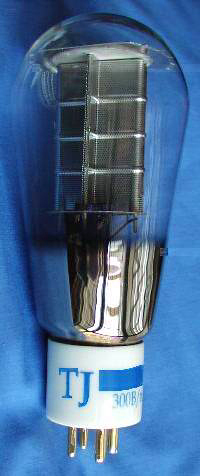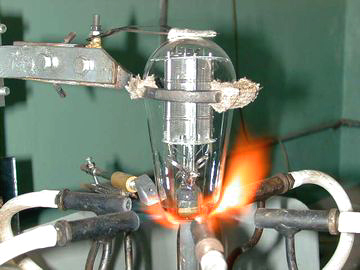|
Tip #34: June 2002 TJ Mesh Plate 300B Gold Pin: an Exclusive first Look by Dick Olsher
The year was 1988. The Western Electric 300B was officially retired at age 51. With the insight of fifty years of hindsight, it is easy to declare the 300B as the premier filamentary power triode of all time. Partly, it is a question of inherent musicality – the grace with which it elucidates midrange detail. But it's also a question of sound engineering. The 300B design combines a reasonable power output in Single-ended operation, with an oxide-coated filament that allows good emission at reasonable plate voltages. The supply void has been filled over the past decade by several new production replicas, most of which fit squarely in the boutique variety. As a result, retail prices have generally been driven to lofty levels. Thorsten Loesch has recently surveyed the 300B field very nicely on Enjoy the Music Review Magazine. Although I agree with most of his findings, especially those dealing with the sound of the TJ Mesh Plate, I find fault with his "reading of the last rites" in the case of the Westrex 300B. It's always a dicey proposition to expound on the sound of various power tubes without regard to the context in which they are operated in. The circuit topology, the choice of operating point, the output transformer, and of course, the loudspeaker, all contribute to the sound of a particular 300B. For the past year I've been auditioning 300Bs, as part of the design and optimization process of a new DIY SE amp design – the T-Rex – aimed at exploiting the full magic of the 300B. The T-Rex is designed to operate at a cathode-plate voltage of 350 volts and a DC quiescent current of 60 mA; a very reasonable operating point that is eminently suitable for a 3K ohm primary impedance transformer. It is also a good choice for the mesh plate 300B, which requires about a 20% plate power derating. A wire mesh is just not as efficient in dissipating heat as is a solid metal design. After months of auditions, two top two contenders emerged: the Westrex 300B and the TJ Mesh Plate. In particular, the TJ Mesh Plate perfectly catered to the needs of T-Rex and the Lowther BassZilla loudspeaker. Sonically, these two tubes are at opposite end of the spectrum, almost Yin and Yang in contrast. The WE is Yang, the element of light, and sounds brighter and airier through the upper octaves. The TJ Mesh Plate is Yin, the element of darkness. It's sound is full-bodied with a center of gravity in the lower midrange. In traditional Chinese medicine Yang creates the air, while Yin creates the senses. This holds true in the case of these two tubes. The TJ Mesh Plate's sound is absolutely sensuous, but without the treble energy of the WE. "Where did the treble go?" was one of my first listening impressions. But after 60 seconds, all was forgiven. You see, it possesses the rare ability to engage and involve the listener. It's dynamic shadings and spatial nuances are second to none. The tube shows off plenty of midrange cleavage. This is the real thing – no silicone implants here – just honest tube lushness. Not surprisingly, this tube is magical with female voice. For many, the TJ Mesh Plate may prove to be the tube of choice, especially in the context of bright speakers. In fact, this tube sounds less like a traditional 300B and more like a PX25 or a 45. Along with my samples of the standard TJ Mesh Plates, DIY HiFi Supply's Brian Cherry also provided me with a pair of the new premium Gold Pin version of this tube (US$350/matched pair). The gold pin version features a strengthened plate structure and better cosmetics. Since the mesh-plate types definitely display more of a personality than solid-plate designs, I wondered if much of their chocolate richness was directly induced by microphonics in the plate structure. The answer appears to be basically no. The TJ gold pin proves the point. Its tonality and character are essentially no different than the standard version – it's just that it's better focused, spatially more incisive and a tad more dynamic. Microphonics, it may be concluded are dirty gremlins, that fuzzy over detail and spatial outlines, but don't expect them to serve up sensuous textures. I use superlatives sparingly in my reviews, but this is not the time to hold back. The TJ Mesh Plate 300B is one incredible sounding tube. Its premium incarnation, the gold pin version does everything a little better yet. The family sound of these tubes represents a mega leap forward in classic tube sound. Listen and you'll be hooked. For me it's been a love affair since my first date.
1. Check for cosmetic and physical defects (loose base etc). Cull out the duds. 2. Curve trace the batch by Sofia Curve Tracer. Cull out the duds. 3. Burn in each tube and listen to for minimum one hour and check for noise, filament distortion and plate glow. Cull out the duds. 4. Curve trace the remaining and check for curve shift (usually 'S' shape). Cull out the duds. 5. Generate best matched pairs and quads with the Sofia matching program. Distributor:
|

 It is important to understand that the TJ Mesh Plate 300Bs are manufactured in small quantities and are therefore subject to slight variations in quality. Since several distributors appear to offer this tube, I would advise purchase only from a supplier that takes care to test and properly match tube pairs. For example, DIY HiFi Paradise in Hong Kong has stated that it screens and selects 300B tubes using the following steps:
It is important to understand that the TJ Mesh Plate 300Bs are manufactured in small quantities and are therefore subject to slight variations in quality. Since several distributors appear to offer this tube, I would advise purchase only from a supplier that takes care to test and properly match tube pairs. For example, DIY HiFi Paradise in Hong Kong has stated that it screens and selects 300B tubes using the following steps: